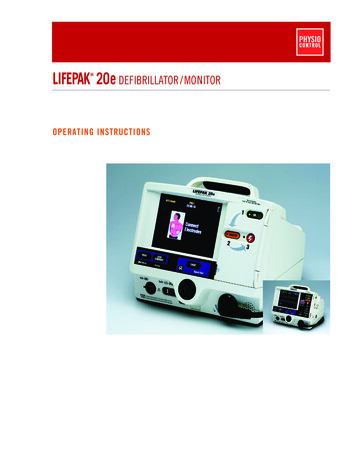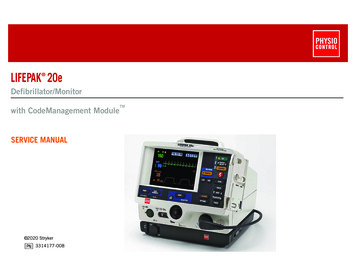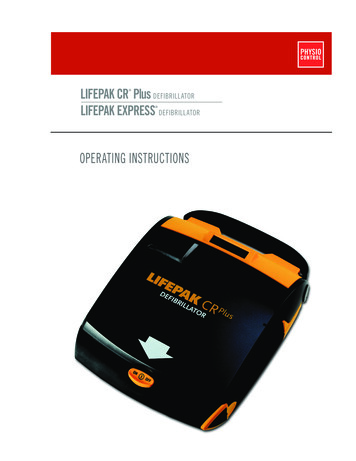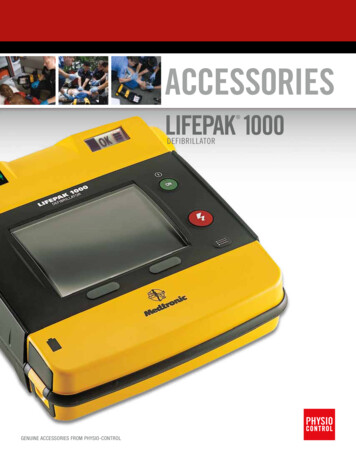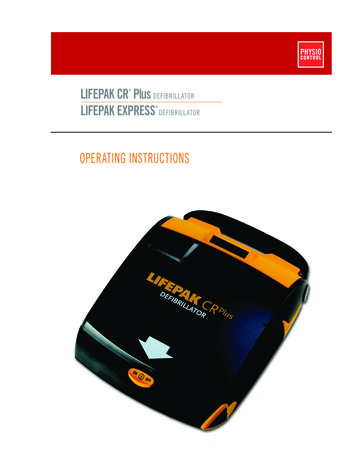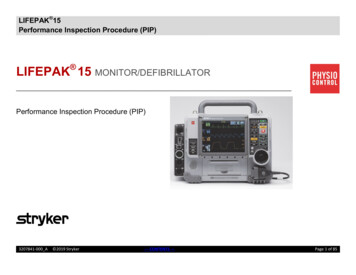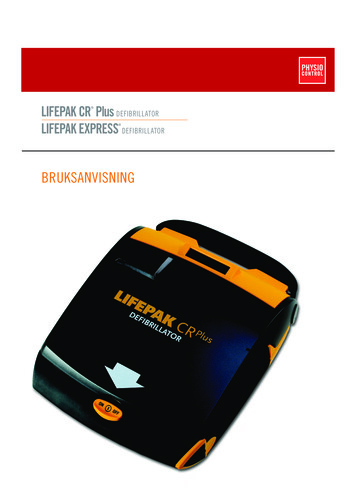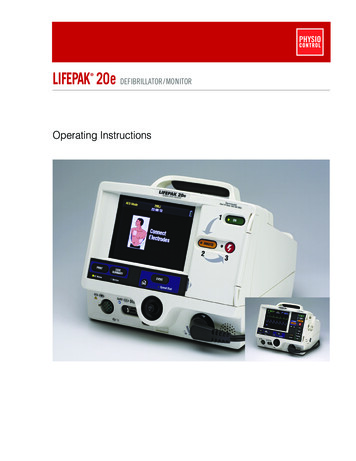
Transcription
LIFEPAK 20e DEFIBRILLATOR/MONITOR Operating Instructions
LIFEPAK 20e DEFIBRILLATOR /MONITOR OPERATING INSTRUCTIONS
Important Information!USA Rx Only!USA Device TrackingThe U.S. Food and Drug Administration requires defibrillator manufacturers and distributors to track thelocation of their defibrillators. If the device is located somewhere other than the shipping address or thedevice has been sold, donated, lost, stolen, exported, destroyed, permanently retired from use, or if thedevice was not obtained directly from Physio-Control, please do one of the following: register the device athttp://www.physio-control.com, call the device tracking coordinator at 1.800.426.4448, or use one of thepostage-paid address change cards located in the back of this manual to update this vital trackinginformation.Text ConventionsThroughout these operating instructions, special text characters are used to indicate labels, screenmessages, and voice prompts: Operating control labels: CAPITAL LETTERS such as ON/OFF and SHOCK. Screen messages and voice prompts: CAPITAL ITALICIZED LETTERS such as CONNECT ELECTRODES.Version HistoryThese operating instructions describe LIFEPAK 20e defibrillator/monitor devices with software version3202609-084 or later.LIFEPAK, FAST-PATCH, DERMA-JEL, QUIK-LOOK, and QUIK-COMBO are registered trademarks of Physio-Control, Inc.ADAPTIV, CODE-STAT, CODE SUMMARY, REDI-PAK, and Shock Advisory System are trademarks of Physio-Control, Inc. Masimoand LNOP are registered trademarks of Masimo Corporation. EDGE System is a trademark of Ludlow Technical Products.Microsoft and Windows are registered trademarks of Microsoft Corporation. Specifications are subject to change without notice. 2006-2015 Physio-Control, Inc.Publication Date: 05/20153205878-016
CONTENTSPrefaceAbout Automated External Defibrillation . viiiAbout Defibrillation Therapy .ixAbout Noninvasive Pacing . xAbout SpO2 Monitoring . xAbout ECG Monitoring . x1 Safety InformationTerms. 1-2General Warnings and Cautions. 1-2Symbols . 1-42 Basic OrientationIntroduction . 2-2Unpacking and Inspecting . 2-2Controls, Indicators, and Connectors . 2-3Area 3. 2-6Area 4. 2-8Area 6. 2-10Changing Printer Paper. 2-11Back View. 2-12Entering Patient Data. 2-13Setting Alarms . 2-14Managing Alarms . 2-16Connecting to Power . 2-17AC Operation. 2-17Battery Operation . 2-17LIFEPAK 20e Defibrillator/Monitor Operating Instructions 2006-2015 Physio-Control, Inc.iii
Battery Performance and Life .2-18Battery Status Indicator .2-183 MonitoringMonitoring the ECG.3-2ECG Monitoring Warning.3-2Selecting ECG Lead and Size .3-2Adjusting the Systole Tone Volume.3-3Monitoring with the Patient ECG Cable .3-5Troubleshooting Tips for ECG Monitoring .3-7Monitoring SpO2 .3-9SpO2 Warnings and Cautions .3-9When to Use a Pulse Oximeter .3-10How a Pulse Oximeter Works.3-10SpO2 Monitoring Considerations.3-11SpO2 Monitoring Procedure .3-12SpO2 Waveform .3-12SpO2 Volume .3-12Sensitivity .3-12Averaging Time .3-13Pulse Oximeter Sensors .3-13Compatibility with Nellcor Sensors .3-13No Implied License .3-13Cleaning .3-13Troubleshooting Tips for SpO2.3-144 TherapyGeneral Therapy Warnings and Cautions.4-2Therapy Electrode and Standard Paddle Placement .4-3Anterior-lateral Placement .4-3Anterior-posterior Placement .4-3Special Placement Situations .4-4Automated External Defibrillation.4-5AED Warnings .4-5AED Setup .4-5AED Procedure.4-6Special AED Setup Options.4-10Troubleshooting Tips for AED Mode .4-13Switching from AED to Manual Mode .4-14Manual Defibrillation.4-14Manual Defibrillation Warnings .4-15Impedance .4-15Defibrillation Procedure .4-16Synchronized Cardioversion Procedure .4-17Remote Synchronization Procedure .4-18Pediatric Defibrillation .4-19Pediatric Paddle Placement .4-19Defibrillation Procedure .4-20Troubleshooting Tips for Defibrillation and Synchronized Cardioversion .4-20Noninvasive Pacing.4-23Noninvasive Pacing Warnings .4-23Demand and Nondemand Pacing .4-23ivLIFEPAK 20e Defibrillator/Monitor Operating Instructions
Noninvasive Pacing Procedure . 4-24Troubleshooting Tips for Noninvasive Pacing . 4-255 Paddle Accessory OptionsTherapy Electrodes. 5-2About Therapy Electrodes. 5-2Electrode Placement . 5-3Cable Connection. 5-4ECG Monitoring and Therapy Procedures . 5-4Replacing and Removing Electrodes . 5-5Testing. 5-6Cleaning and Sterilizing. 5-6Standard Paddle Set (Optional) . 5-7About the Standard Paddle Set. 5-7Accessing the Pediatric Paddles . 5-7Replacing the Adult Paddle Attachment. 5-8Cleaning the Standard Paddle Set . 5-8Sterilizable Internal Defibrillation Paddles . 5-96 Data ManagementOverview of Data Storage and Retrieval . 6-2Data Storage . 6-2Report Types. 6-2Memory Capacity . 6-2CODE SUMMARY Report . 6-2Preamble . 6-3Event/Vital Signs Log . 6-3Waveform Events . 6-4CODE SUMMARY Format . 6-5Managing Archived Patient Records . 6-7Entering Archives Mode. 6-7Printing Archived Patient Reports . 6-7Editing Archived Patient Records . 6-9Deleting Archived Patient Records . 6-10Overview of Connections for Transmitting Reports . 6-117 Maintaining the EquipmentGeneral Maintenance and Testing. 7-2Maintenance and Testing Schedule . 7-2Daily Auto Test . 7-3User Test. 7-4Cleaning . 7-5Function Checks. 7-5General Troubleshooting Tips . 7-10Service and Repair . 7-12Product Recycling Information . 7-12Recycling Assistance . 7-12Preparation. 7-12Recycling of Disposable Electrodes . 7-12Packaging. 7-12Warranty . 7-12Accessories, Supplies, and Training Tools . 7-13LIFEPAK 20e Defibrillator/Monitor Operating Instructions 2006-2015 Physio-Control, Inc.v
8 Setup OptionsSetup Options .8-2Print Configurations Before Service or Repair.8-2Passcode Security .8-2Entering Setup Options .8-3General Setup Menu .8-4Manual Mode Setup Menu .8-5AED Mode Setup Menu .8-7Pacing Setup Menu.8-8Monitoring Menu .8-9Channels Setup Menu .8-9Waveform Sets Setup Menu.8-9Events Setup Menu.8-10Alarms Setup Menu.8-10Printer Setup Menu .8-11Auto Print Setup Menu .8-11Clock Setup Menu.8-12Reset Defaults Setup Menu .8-12Print Defaults.8-12Send Configuration Setup Menu .8-13Set Passcodes Setup Menu.8-13Service Mode .8-13A Specifications and Performance CharacteristicsB Clinical SummariesC Screen MessagesD Operator’s ChecklistE Shock Advisory SystemF SpO2 Clinical Validation SummariesG About cprMAX TechnologyH Docking StationI Electromagnetic Compatibility GuidanceIndexviLIFEPAK 20e Defibrillator/Monitor Operating Instructions
PrefacePREFACEAbout Automated External DefibrillationAbout Defibrillation TherapyAbout Noninvasive PacingAbout SpO2 MonitoringAbout ECG MonitoringLIFEPAK 20e Defibrillator/Monitor Operating Instructions 2006-2015 Physio-Control, Inc.page viiiixxxxvii
PrefaceABOUT AUTOMATED EXTERNAL DEFIBRILLATIONThe following considerations and guidelines apply when using the LIFEPAK 20e defibrillator/monitor as an automated external defibrillator (AED).Operator ConsiderationsThe LIFEPAK 20e defibrillator/monitor, when in AED mode, is a semiautomatic defibrillator thatuses a patented Shock Advisory System . This software algorithm analyzes the patient’selectrocardiographic (ECG) rhythm and indicates whether or not it detects a shockable rhythm.The LIFEPAK 20e defibrillator/monitor in AED mode requires operator interaction to defibrillatethe patient.The LIFEPAK 20e defibrillator/monitor in AED mode is intended for use by personnel who areauthorized by a physician/medical director and have, at a minimum, the following skills andtraining: CPR training. AED training equivalent to that recommended by the American Heart Association. Training in the use of the LIFEPAK 20e defibrillator/monitor in AED mode.For information about training options, contact your local Physio-Control representative.IndicationsThe AED mode is to be used only on patients in cardiopulmonary arrest. The patient must beunconscious, pulseless, and not breathing normally before using the defibrillator to analyze thepatient’s ECG rhythm.In AED mode, the LIFEPAK 20e defibrillator/monitor is not intended for use on pediatric patientsless than 8 years old.ContraindicationsNone known.viiiLIFEPAK 20e Defibrillator/Monitor Operating Instructions
PrefacePrefaceABOUT DEFIBRILLATION THERAPYOperator ConsiderationsA direct current defibrillator applies a brief, intense pulse of electricity to the heart muscle. TheLIFEPAK 20e defibrillator/monitor delivers this energy through disposable electrodes, standardpaddles or internal paddles applied to the patient’s chest.Defibrillation is only one aspect of the medical care required to resuscitate a patient with ashockable ECG rhythm. Depending on the situation, other supportive measures may include: Cardiopulmonary resuscitation (CPR) Administration of supplemental oxygen Drug therapySuccessful resuscitation is related to the length of time between the onset of a heart rhythm thatdoes not circulate blood (ventricular fibrillation, pulseless ventricular tachycardia) anddefibrillation. The American Heart Association has identified the following as critical links in thechain of survival from cardiac arrest: Early access Early CPR by first responders or bystanders Early defibrillation Early advanced life supportThe physiological state of the patient may affect the likelihood of successful defibrillation. Thus,failure to resuscitate a patient is not a reliable indicator of defibrillator performance. Patients willoften exhibit a muscular response (such as jumping or twitching) during an energy transfer. Theabsence of such a response is not a reliable indicator of actual energy delivery or deviceperformance.IndicationsDefibrillation is a recognized means of terminating certain potentially fatal arrhythmias, such asventricular fibrillation and symptomatic ventricular tachycardia. Delivery of this energy in thesynchronized mode is a method for treating atrial fibrillation, atrial flutter, paroxysmalsupraventricular tachycardia and, in relatively stable patients, ventricular tachycardia.ContraindicationsDefibrillation is contraindicated in the treatment of Pulseless Electrical Activity (PEA) such asidioventricular or ventricular escape rhythms, and in the treatment of asystole.LIFEPAK 20e Defibrillator/Monitor Operating Instructions 2006-2015 Physio-Control, Inc.ix
PrefaceABOUT NONINVASIVE PACINGA noninvasive pacemaker is a device that delivers an electrical stimulus to the heart, causingcardiac depolarization and myocardial contraction. The energy is delivered through largeadhesive electrodes placed on the chest. In addition to noninvasive pacing, other supportivemeasures may be necessary.Among other factors, it is recognized that successful pacing of a patient is related to the length oftime between the onset of a dysrhythmia and the initiation of pacing. Rapid pacing and promptfollow-up care are essential. The physiologic state of the patient may affect the likelihood ofsuccessful pacing or of skeletal muscle activity. The failure to successfully pace a patient is not areliable indicator of pacemaker performance. Similarly, the patient’s muscular response to pacingis not a reliable indicator of energy delivered. Refer to the booklet, Noninvasive Pacing: What YouShould Know for further information.IndicationsNoninvasive pacing is indicated for symptomatic bradycardia in patients with a pulse.ContraindicationsNoninvasive pacing is contraindicated for the treatment of ventricular fibrillation and asystole.ABOUT SPO2 MONITORINGA pulse oximeter is a noninvasive device that checks the saturation of oxygen in arterial blood(SpO2). It uses an optical sensor that directs light through the patient’s finger and then measuresthe received light with a detector. This received light is translated into a saturation percentageand is displayed as an SpO2 reading.IndicationsA pulse oximeter is indicated for use in any patient who is at risk of developing hypoxemia.ContraindicationsNone known.ABOUT ECG MONITORINGThe ECG (electrocardiogram) is a recording of the electrical activity of the heart. ECG monitoringallows for identification and interpretation of cardiac rhythms or dysrhythmias and calculation ofheart rate. The ECG is obtained by placing either electrodes or paddles on the patient and allowsthe heart’s electrical activity to be monitored and recorded.xLIFEPAK 20e Defibrillator/Monitor Operating Instructions
SAFETY INFORMATION1 Safety InformationThis section provides important information to help you operate the LIFEPAK 20e defibrillator/monitor. Familiarize yourself with all of these terms, warnings, and symbols.TermsGeneral Warnings and CautionsSymbolsLIFEPAK 20e Defibrillator/Monitor Operating Instructions 2006-2015 Physio-Control, Inc.page 1-21-21-41-1
Safety InformationTERMSThe following terms are used either in these operating instructions or on the LIFEPAK 20edefibrillator/monitor:Danger: Immediate hazards that will result in serious personal injury or death.Warning: Hazards or unsafe practices that may result in serious personal injury or death.Caution: Hazards or unsafe practices that may result in minor personal injury, product damage,or property damage.GENERAL WARNINGS AND CAUTIONSThe following are general warning and caution statements. Other specific warnings and cautionsare provided as needed in other sections of these operating instructions.WARNINGS!Shock hazard.The defibrillator delivers up to 360 J of electrical energy. Unless properly used as described inthese operating instructions, this electrical energy may cause serious injury or death. Do notattempt to operate this device unless thoroughly familiar with these operating instructions andthe function of all controls, indicators, connectors, and accessories.Shock hazard.Do not disassemble the defibrillator. It contains no operator serviceable components anddangerous high voltages may be present. Contact authorized service personnel for repair.Shock hazard.To avoid the risk of electrical shock, this equipment must only be connected to a supply mainswith protective earth.Shock or fire hazard.Do not immerse any portion of this defibrillator in water or other fluids. Avoid spilling any fluids ondefibrillator or accessories. Spilled liquids may cause the defibrillator and accessories to performinaccurately or fail. Do not clean with ketones or other flammable agents. Do not autoclave orsterilize this defibrillator or accessories unless otherwise specified.Possible fire or explosion.Do not use this device in the presence of flammable gases or anesthetics. Use care whenoperating this device close to oxygen sources (such as bag-valve-mask devices or ventilatortubing). Turn off gas source or move source away from patient during defibrillation.Possible electrical interference with device performance.Equipment operating in close proximity could emit strong electromagnetic or radio frequencydisturbances that could cause electromagnetic interference (EMI) and affect the performance ofthis defibrillator. EMI may result in improper defibrillator operation, distorted ECG, failure todetect a shockable rhythm, or cessation of pacing. Avoid operating the defibrillator nearcauterizers, diathermy equipment, cellular phones, or other portable and mobile RFcommunications equipment. Maintain equipment separation of at least 1.2 m (4 ft) and do notrapidly key EMS radios on and off. Contact a technical support representative if assistance isrequired.1-2LIFEPAK 20e Defibrillator/Monitor Operating Instructions
Safety InformationWARNINGS! (CONTINUED)Possible electrical interference.Using cables, electrodes, or accessories not specified for use with this device may result inincreased emissions or decreased resistance to electromagnetic interference which could affectthe performance of this device or of equipment in close proximity. Use only parts andaccessories specified in these operating instructions.Possible electrical interference.This defibrillator may cause electromagnetic interference (EMI) especially during charge andenergy transfers. EMI may affect the performance of equipment operating in close proximity.Verify the effects of defibrillator discharge on other equipment prior to using defibrillator in anemergency situation, if possible.Possible electrical interference.1 Safety InformationThis defibrillator should not be used adjacent to or stacked with other equipment. If adjacent orstacked use is necessary, the defibrillator should be observed to verify normal operation in theconfiguration in which it will be used.Possible defibrillator shutdown.When operating on battery power, adhere to battery maintenance and replacement intervalsdiscussed in the Battery Performance and Life section to prevent possible defibrillator shutdown.If the defibrillator shuts down without warning, or if a LOW BATTERY: CONNECT TO ACPOWER message appears on the monitor screen, immediately connect the AC power cord toan outlet.Possible device failure.Do not modify the defibrillator.Possible equipment damage.Use only ECG cables that are specified for use with this device. Protection of the device againstdefibrillator discharge is dependent on the use of ECG cables that are specified byPhysio-Control.Possible improper defibrillator performance.Changing factory default settings will change the behavior of the device. Changes to the defaultsettings must only be made by authorized personnel.Possible improper defibrillator performance.Using other manufacturers’ cables, electrodes, or batteries may cause the device to performimproperly and invalidates the safety agency certification. Use only the accessories specified inthese operating instructions.Possible failure to detect an out of range condition.Reselecting QUICK SET will reset the alarm limits around the patient’s current vital sign values.This may be outside the safe range for the patient.Safety risk and possible equipment damage.MR unsafe: keep the defibrillator away from magnetic resonance imaging (MRI) equipment.Possible Patient BurnsA defect in the neutral electr
LIFEPAK 20e Defibrillator/Monitor Operating Instructions ix 2006-2015 Physio-Control, Inc. ABOUT DEFIBRILLATION THERAPY Operator Considerations A direct current defibrillator applies a brief, intense pulse of electricity to the heart muscle. The LIFEPAK 20e defibrillator/monitor delivers this energy through disposable electrodes, standard
